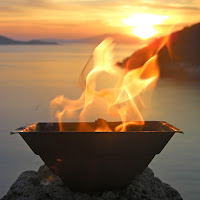Om Agni Namaha
They had been married for
over twenty years and in all these years, Mr and Mrs Sharma visited the temple
as a daily ritual and lit an oil diya
(lamp with a wick) to invoke light into darkness. As a symbol of the advent of
wisdom, temples usually have diyas lit in them. Mr Sharma believed there was a
certain mystical quality to the light of the flame of a diya that cannot be
substituted by electrical lights. The light of the flame he believed, has a
certain degree of aliveness to it, which is absent in the electrical lights
trapped in a glass dome or tube. Perhaps, the freedom of the flame and its
direct facade of the Fire element (Agni) in a well-behaved manner made it so
unique for this couple. They even took their wedding vows with the sacred fire
as a witness, which is a common custom in India, and he worshiped Agni ever
since then.
His neighbour, Daya who
lived in the house next to theirs, was not a ritualistic person, but somehow
was enchanted whenever he saw Mr Sharma perform the Agni yagya, (a worship of
the sacred Fire). Seeing his interest and eagerness to know more about this
ritual, Mr Sharma invited him over when he performed the yagya. Daya looked on
curiously through the whole process; the setting up of the vedi (the base of
bricks and sand), and decorating it with turmeric, vermilion, and wheat flour
to make a symbol of the planets and the sun and moon. Mr Sharma explained that
this was an invocation to these heavenly bodies to seek their blessings and
propitiate them for peace of all.
Then Mr Sharma set up the dry mango-twigs for
the fire, preparing the offerings that would go into it. The offerings were
mainly ghee, milk, honey, sesame seeds, and a herbal mixture, with nuts and
coconut. Camphor was used as a fire-starter and some mango leaves tied to a
twig were used as a spoon to pour ghee into the sacred fire along with the
chanting of Vedic mantras. Some home-made sweets, fruits and flowers were also
offered. Agni the sacred Fire, was the deity of the yagya and was propitiated
by this ritual and blessed by the sun, moon, and planets for the well-being of
all.
When the yagya was
accomplished, Daya asked Mr Sharma, what did all this signify? This seemed to
be so symbolic, and if it were really relevant in today’s modern day
life-style?
Mr Sharma, who was ardent
devotee of Agni, told Daya that this was indeed symbolic. He further explained
that Fire element, which is a tremendous phenomenon of Nature, represented the
digestive fire here. This fire is lit up first and then the offering is placed
into it. The nature of offerings determined the aroma emitted, as Agni/Fire has
no odour of its own. So whatever we consume through our digestive fire also
determines the odours that we emit, even to the extent the thoughts that we
generate have a subtle odour. So just like we light the fire before placing the
offering, we should awaken the digestive fire before placing the offering of
foods into it. By this he meant to awaken hunger and then eat, or eat only when
hungry.
He then mentioned that the
funeral pyre too has Agni, but that is much different, as in that case, the
offering is placed first and then the fire is lit. So if you are eating first
and awakening the fire afterwards, it results in degradation of the body
material. This was also essential for the cleansing of the body tissues where
wastes accumulated over long periods of time can be burnt and got rid off.
He further explained that we all need a
balance of these two types of yagyas, one for creative or constructional
purposes, and the degradation one for cleansing purposes.
Daya then inquired about the
flame of the diyas and candles in sacred places. Mr Sharma got up from his seat
and came nearer to Daya; he touched the sides of his forehead and said, “You
call these as temples in English. It is very rightly so, as these are the gateways
to the seat of the soul, that is the so called third eye; in the middle of the
eyebrows. When we visit the temple outside we are actually looking for a
gateway, a passage to the soul. Lighting of the lamp in the temples is symbolic
of lighting the diya of knowledge, to ultimately come to the knowledge of our own
soul, which is the inherent, pure knowledge from within, which is commonly
referred to as atma-gyaan among
Indians.
Thus fire is a source of
light and light brings knowledge, which makes everything visible in the outer
world, is an inspiration for us to plunge into the unknown realm of darkness or
ignorance (gross material existence) to find our way back from where we
originated.
Agni is associated with
light as it is a unique element it always raises itself up by a natural inborn
tendency to raise upwards, it is also an equaliser in its own right as fire doesn't know what you think of as
precious or trash, it burns whatever is offered into it. It makes you aware of the
nature of things. It burns your beliefs and ideas about things and uncovers the
true nature of a substance by the odours they emit. For example some chemicals would
give out smoke and fumes, but incense lets out fragrance. It is so much like
suffering that does not distinguish between the status and substance of man, it
invariably inflicts, but what type of emission happens in that state is a
matter of one's substance and constitution.”
As Daya listened with
interest to Mr Sharma’s explanation, he thought of the sacred fire of wedding
ceremonies and asked about the significance of that Agni.
“As marriage is the union of
two souls, and you know nothing unites better than fire. Just as elements come
together and unite in the heat of the sun to produce plants where none of the
elements is seen as separate, so a marital union is symbolically blessed by the
fire of desire that unites two souls together in a mutually beneficial
association.
Like water and rice coming
together to be cooked over the fire to unite and give a palatable meal! So we are cooked in this fire of wedding and
sometimes feel the heat positively at other times negatively, but cooking
happens for sure. Well here the kids eat the meal, ha-ha...” Mr Sharma laughed
as he said.
~Om Agni Namah~



Comments
Post a Comment